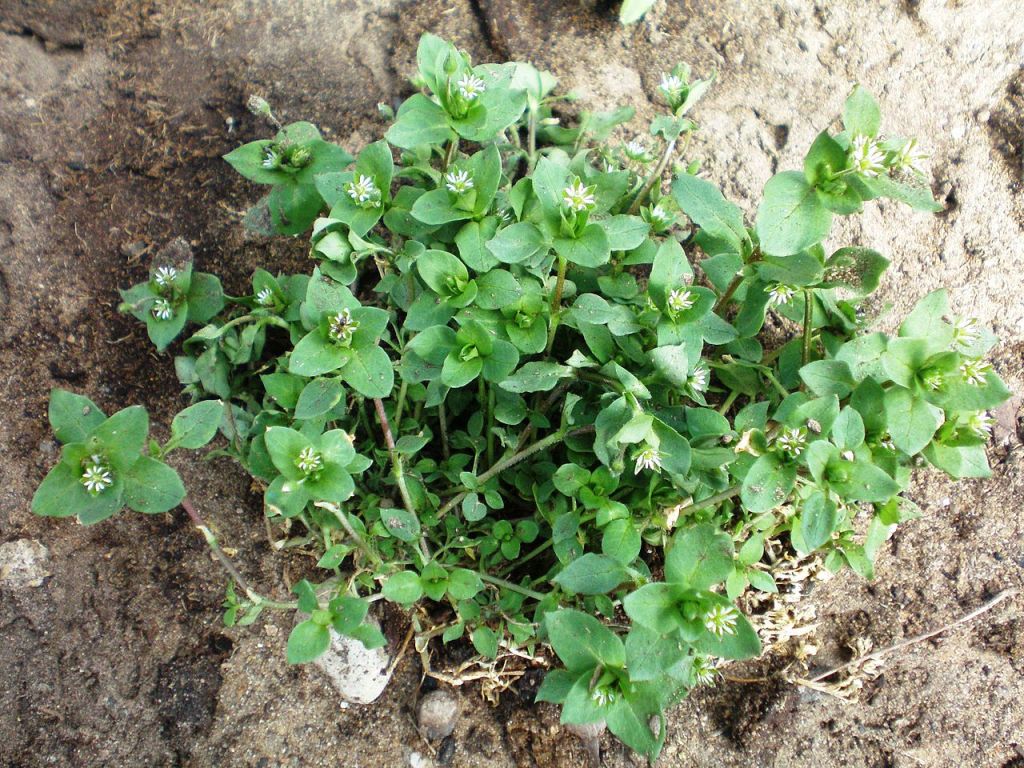
Chickweed or Stellaria media
is one of the weeds mentioned on the RHS site.
So a good reason for a post on this plant and its relatives!
The Caryophyllaceae or Pink/Campion Family is a large family in the B.I. It is therefore subdivided into 3 Subfamilies:
- 1 Subfamily Alsinoideae with 11 genera (genera 1-11) covered in this week’s post.
- 2 Subfamily Paronychioideae with 5 genera (genera 12-17)
- 3 Subfamily Caryophylloideae with 6 genera (genera 18-24)
Links on the scientific names is info from the Plant Atlas 2020. Links on the common names are often Wikipedia, where you can also find pictures in Wikipedia Commons or occasionally from another website. The coloured backgrounds are blue for the habitat information as found in the Online Plant Atlas 2020 as well as for general interesting facts. Green is for all sorts of uses such as food, ornamental, wildlife, etc. Pink is for medicinal use.
If described in the Flora of Birmingham and the Black Country it will be highlighted by FBBC in the Content page.
Contents of Subfamily Alsinoideae:
1 Arenaria spp. or Sandworts
- A. serpyllifolia or Thyme-leaved Sandwort FBBC
- A. leptoclados or Slender Sandwort FBBC
- A. norvegia with 2 subspecies: ssp norvegia or Arctic Sandwort and ssp anglica or English Sandwort
- A. ciliata or Fringed Sandwort
- A. balearica or Mossy Sandwort FBBC
- A. montana or Large-flowered Sandwort
2 Moehringia trinervia or Three-nerved Sandwort FBBC
3 Honckenya peploides or Sea Sandwort
4 Minuartia spp.
- M. recurva or Recurved Sandwort
5 Sabulina tenuifolia or Fine-leaved Sandwort
- S. verna or Spring Sandwort
- S. rubella or Mountain Sandwort
- S. stricta or Teesdale Sandwort
6 Cherleria sedoides or Cyphel
7 Stellaria spp or Chickweeds
Stellaria media or Chickweed FBBC
- S. nemorum or Wood Stitchwort FBBC
- S. pallida or Lesser Chickweed FBBC
- S. neglecta or Greater Chickweed FBBC
- S. holostea or Greater Stitchwort FBBC
- S. palustris or Marsh Stitchwort
- S. graminea or Lesser Stitchwort FBBC
- S. alsine or Bog Stitchwort FBBC
- S. aquatica or Water Chickweed (syn. Myosoton aquaticum) FBBC
8 Holosteum umbellatum or Jagged Chickweed
9 Cerastium spp or Mouse-Ears
- C. cerastoides or Starwort Mouse-ear
- C. arvense or Field Mouse-ear FBBC
- C. arvense x C. tomentosum or Hybrid Mouse-Ear FBBC
- C. tomentosum or Snow-in-summer FBBC
- C. alpinum or Alpine Mouse-ear
- C. nigrescens or Arctic Mouse-ear
- C. fontanum or Common Mouse-ear FBBC
- C. glomeratum or Sticky Mouse-ear FBBC
- C. brachypetalum or Grey mouse-ear
- C. diffusum or Sea Mouse-ear FBBC
- C. pumilum or Dwarf Mouse-ear
- C. semidecandrum or Little Mouse-ear FBBC
10 Moenchia erecta or Upright Chickweed FBBC
11 Sagina spp or Pearlworts
- S. nodosa or Knotted Pearlwort FBBC
- S. nivalis or Snow Pearlwort
- S. subulata or Heath Pearlwort
- S. saginoides or Alpine Pearlwort
- S. x normaniana or Scottish Pearlwort
- S. procumbens or Procumbent Pearlwort FBBC
- S. apetala or Annual Pearlwort FBBC
- S. filicaulis or Slender Pearlwort FBBC
- S. maritima or Sea Pearlwort
12 Scleranthus spp or Knawels
- S. perennis or Perennial Knawel with 2 subspecies: ssp. perennis and ssp. prostratus
- S. annuus or Annual Knawewel with 2 subspecies: ssp. annuus and ssp. polycarpos FBBC
